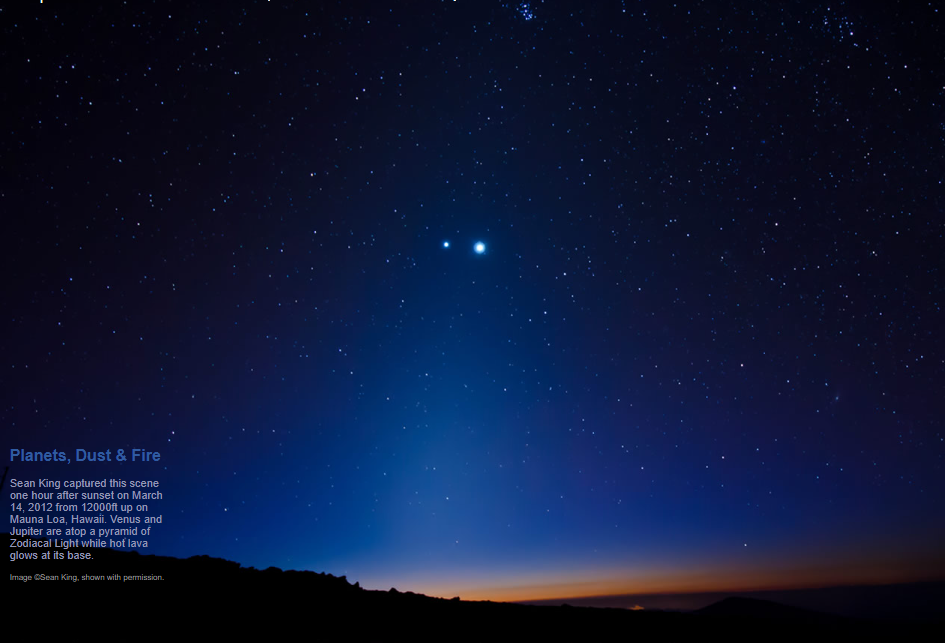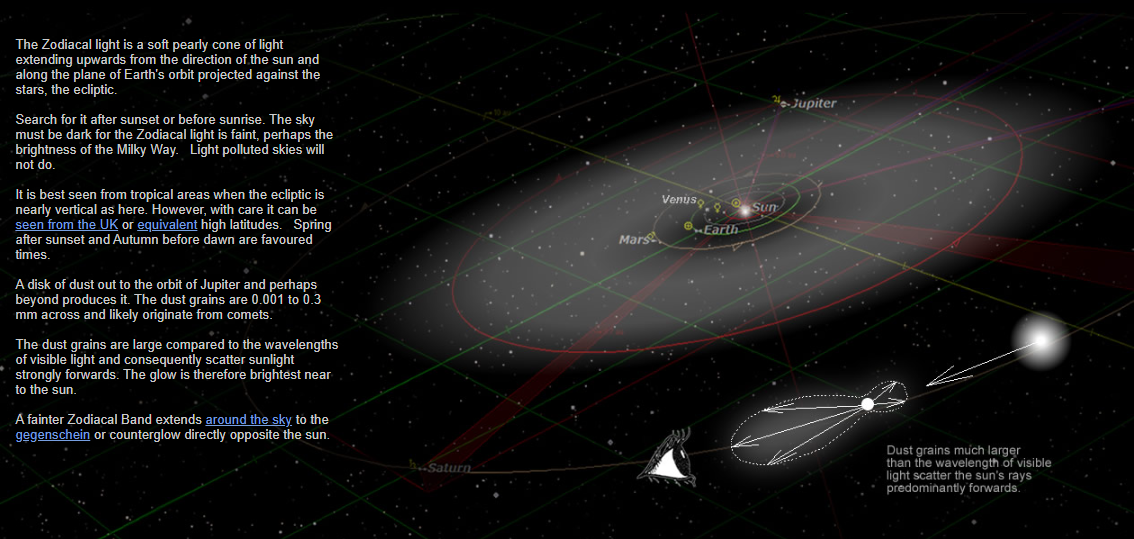OPOD -Zodiacal Light, Fire, Planets
OPOD - Zodiacal Light, Fire, Planets: A Phenomenon of Dust and Celestial Beauty
Zodiacal light is a captivating celestial phenomenon that graces the night sky. It manifests as a soft pearly cone of light extending upwards from the direction of the sun, along the plane of Earth's orbit projected against the stars known as the ecliptic. The ethereal glow of Zodiacal light is best observed after sunset or before sunrise when the sky is dark, as it is faint, comparable in brightness to the Milky Way. However, it is important to find a location away from light pollution to truly appreciate its delicate radiance.
This celestial spectacle is most prominently visible from tropical areas, where the ecliptic is nearly vertical. Nevertheless, with careful observation, it can also be spotted from higher latitudes such as the UK. The optimal times to catch a glimpse of Zodiacal light are during spring after sunset and autumn before dawn.
The origin of Zodiacal light lies in a disk of dust that extends from Earth's orbit to the orbit of Jupiter, and possibly beyond. These dust grains, measuring between 0.001 and 0.3 mm in size, likely originate from comets. Due to their relatively large size compared to the wavelengths of visible light, these particles scatter sunlight strongly in the forward direction, resulting in the radiant glow near the sun.
While the Zodiacal light forms the apex of this celestial pyramid, there is more to behold. At its base, photographer Sean King captured a mesmerizing sight from Mauna Loa, Hawaii. Atop the pyramid of Zodiacal Light, Venus and Jupiter adorn the night sky, while hot lava adds its fiery glow to the scene. This unique combination creates a captivating interplay between the celestial and earthly elements.
But the Zodiacal light doesn't end there. A fainter counterpart, known as the Zodiacal Band, encircles the sky, extending towards the gegenschein or counterglow directly opposite the sun. This additional band adds an extra layer of celestial beauty to the night sky, enhancing the wonder of the Zodiacal light phenomenon.
In summary, the Zodiacal light is a breathtaking spectacle that enchants observers worldwide. Its soft pearly glow, extending from the direction of the sun along the plane of Earth's orbit, creates a stunning visual display. This ethereal phenomenon is best observed from dark, unpolluted skies and is most prominent in tropical areas. Its origin lies in a disk of dust particles, likely originating from comets, which scatter sunlight forward, resulting in its radiant appearance. Whether capturing Venus and Jupiter atop the pyramid of Zodiacal Light or gazing at the fainter Zodiacal Band encircling the sky, the allure of this celestial phenomenon continues to captivate and inspire all who witness its beauty.

Planets, Dust & Fire
Sean King captured this scene one hour after sunset on March 14, 2012 from 12000ft up on Mauna Loa, Hawaii. Venus and Jupiter are atop a pyramid of Zodiacal Light while hot lava glows at its base.
Image ©Sean King, shown with permission.

The Zodiacal light is a soft pearly cone of light extending upwards from the direction of the sun and along the plane of Earth's orbit projected against the stars, the ecliptic.
Search for it after sunset or before sunrise. The sky must be dark for the Zodiacal light is faint, perhaps the brightness of the Milky Way. Light polluted skies will not do.
It is best seen from tropical areas when the ecliptic is nearly vertical as here. However, with care it can be seen from the UK or equivalent high latitudes. Spring after sunset and Autumn before dawn are favoured times.
A disk of dust out to the orbit of Jupiter and perhaps beyond produces it. The dust grains are 0.001 to 0.3 mm across and likely originate from comets.
The dust grains are large compared to the wavelengths of visible light and consequently scatter sunlight strongly forwards. The glow is therefore brightest near to the sun.
A fainter Zodiacal Band extends around the sky to the gegenschein or counterglow directly opposite the sun.
Note: this article has been automatically converted from the old site and may not appear as intended. You can find the original article here.
Reference Atmospheric Optics
If you use any of the definitions, information, or data presented on Atmospheric Optics, please copy the link or reference below to properly credit us as the reference source. Thank you!
-
<a href="https://atoptics.co.uk/blog/opod-zodiacal-light-fire-planets/">OPOD -Zodiacal Light, Fire, Planets</a>
-
"OPOD -Zodiacal Light, Fire, Planets". Atmospheric Optics. Accessed on November 26, 2024. https://atoptics.co.uk/blog/opod-zodiacal-light-fire-planets/.
-
"OPOD -Zodiacal Light, Fire, Planets". Atmospheric Optics, https://atoptics.co.uk/blog/opod-zodiacal-light-fire-planets/. Accessed 26 November, 2024
-
OPOD -Zodiacal Light, Fire, Planets. Atmospheric Optics. Retrieved from https://atoptics.co.uk/blog/opod-zodiacal-light-fire-planets/.